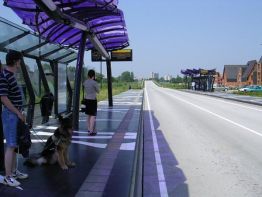Project Aim
The overall, long-term aim of HiTrans was to achieve more sustainable transport in medium size cities and urban regions in the North Sea Region by facilitating the development of High Quality Public Transport. Therefore the project has intended to support the development of public transport schemes. Furthermore the project aimed to influence national and regional governmental policies and attitudes towards new concepts of High Quality Public Transport.
Project implementation and results
Innovative solutions
HiTrans main achievement was a best practice guide on High Quality Public transport in medium size cities and urban regions which offers professional planners a very useful and practical tool. It presents a broad scope covering a wide range of aspects from public transport and land use, network design, urban design, technical issues and citizen’s requirements.
Additionally the five HiTrans best parctice guides also contain a recommended set of guidelines, both technical and methodological, that can be applied by transport authorities throughout the EU. All the five best practice guides contain a number of examples with successful cities that have in different ways been successful in establishing high quality public transport. The five guides give the professional reader a broad overview in all the main aspects; this highlights a key strength within the HiTrans-project.
Joint transnational strategy
Mode of cooperation
The HiTrans project focused on transnational research to develop principles and strategies for introducing high quality public transport in medium sized cities and urban regions.
Impact of the project
Policy shaping
The project partners have continued their cause in an effort to investigate and gradually try to implement rail-based high quality public transport in their respective city and region. One of these partners was Århus (DK) where it was concluded a few years ago that a bus based concept should be applied. Due to the work however, the project the politicians in DK revised this conclusion and are now looking for a partial rail based concept. Also for the Scottish partners, the project has demonstrated the potential of a tram-train system, which before was considered a 'no option' in Scotland.
After the closure of the project, the partners are now using the HiTrans guidelines in their respective research and planning of public transport.
Dissemination
Not only the HiTrans partners found the HiTrans best practice guides to be useful, 120 delegates from 11 different European countries took part at the HiTrans conference. Furthermore HiTrans attracted interest from other parts of the world. By September 2005 HiTrans had been contacted by universities in USA, Australia and Nigeria wanting to order the HiTrans Best Practice guide. During the last few months, the guides were distributed to a large number of companies, institutions and persons and they will still be available for ordering on the project website. |

Rapid-bus stop in the Netherlands
Partners Århus County Council, DK
Jernbaneverket, NO
NBS,NO
Oslo Sporveier, NO
Statens Vegvesen, Rogaland, NO
Stavanger and Sandnes City Councils, NO
City of Helsingborg, SE
City of Edinburgh Council, UK
Tyne and Wear Passenger Transport Authority (NEXUS), UK
City of Sunderland, UK
LP:
Rogaland County Council
Project Manager
Per Frøyland Pallesen
Rogaland County Council Arkitekt Eckhoffsgate 1
P.O. Box 130 N-4001 Stavanger
Norway
pfp@rogfk.no
www.hitrans.org
Tel: +47 5151 6681
Measure: 2.1
Start Date: 01 March 2002
End Date: 31 December 2005
ERDF Grant:
 550.275,00 550.275,00
Total Eligible Sum:
 1.100.550,00 1.100.550,00
|